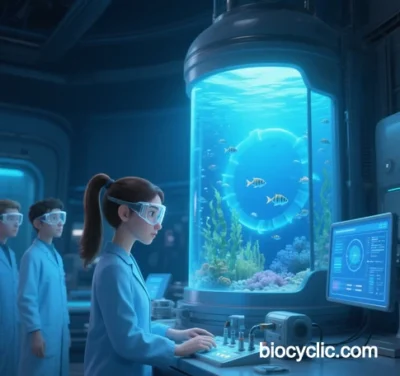
Panoramic Applications of the Bio-cyclic Concept: A Cross-Disciplinary Revolution
Bio-cyclic systems, as a fusion of circular economy principles and biotechnology, harness biological metabolic processes to achieve closed-loop resource regeneration and systemic sustainability. Beyond traditional agriculture and waste management, this paradigm now permeates cutting-edge fields such as materials science, energy systems, advanced manufacturing, and urban design. Below is a comprehensive analysis of its innovative applications across eight domains, refined for technical precision and optimized for readability.
I. Innovations in Bio-based Materials
1. High-Performance Bioplastics
- Bio-cyclic Monomers: Compounds like isosorbide and vanillin, derived from renewable sources, enable the synthesis of polyesters with glass transition temperatures (Tg) exceeding 120°C. For example, isosorbide-based polyurethanes address the brittleness of PLA while maintaining full biodegradability .
- Closed-Loop Bioplastics: Utilizing food industry waste (e.g., sugarcane bagasse, coffee grounds), 5-hydroxymethylfurfural (HMF) and citric acid are converted into recyclable bio-polyester films for food packaging via green chemistry .
2. Programmable Degradation
- Industrial Composting: Balena’s BioCir™ materials decompose fully within 180 days in industrial composters, reducing microplastic pollution by 97% and enabling applications in 3D-printed footwear and fast fashion .
- Smart Packaging: Chitin- and lignin-based films release antimicrobial peptides in response to environmental conditions, extending food shelf life while ensuring compostability .
II. Transforming Textiles and Fashion
1. Bio-based Fibers
- Plant-Based Alternatives: Pineapple leaf fiber (Piñatex) and mycelium leather replicate animal leather’s mechanical properties with 85% lower carbon emissions .
- Marine Biomass: Alginate fibers from brown algae offer natural flame resistance and antimicrobial properties, degrading harmlessly in seawater .
2. Sustainable Dyeing
- Microbial Pigments: Engineered actinomycetes produce indigo and alizarin red, reducing dye toxicity by 90% and achieving yields of 5g/L .
- Circular Water Systems: Microbial fuel cells (MFCs) coupled with constructed wetlands treat textile wastewater, removing organic dyes and recovering 0.8 kWh/m³ of energy .

III. Regenerative Agriculture and Soil Health
1. Veganic Farming
- Animal-Free Systems: Bio-cyclic humus replaces manure, boosting soil organic carbon by 230% and reducing pesticide residues by 70% through legume nitrogen fixation and green manure .
- Microbial Consortia: Synthetic communities (e.g., Azospirillum + arbuscular mycorrhizal fungi) enhance rhizosphere ecology, increasing potato yields by 22% without synthetic nitrogen in German trials .
2. Saline Soil Remediation
- Halophyte-Microbe Symbiosis: Suaeda salsa paired with salt-tolerant rhizobia fixes 8 tons of CO₂/ha annually while reducing soil salinity from 1.8% to 0.5%, converting barren lands into productive farms .
IV. Industrial and Chemical Transformation
1. Biorefineries
- Multi-Product Systems: Lignocellulosic biomass is converted into platform chemicals (e.g., HMF, itaconic acid), biodiesel, and bioplastics with 92% resource efficiency .
- Carbon-to-Polymer: Cyanobacteria and acetogens transform industrial CO₂ emissions into polyhydroxyalkanoates (PHA), yielding 0.4 tons of bioplastic per ton of CO₂ .
2. Enzymatic Catalysis
- Green Polymerization: Lipase-catalyzed ring-opening polymerization produces 100% bio-based polycaprolactone (PCL) at 40°C (vs. 200°C for conventional methods), slashing energy use by 75% .
V. Energy System Overhaul
1. Advanced Bioenergy
- Supercritical Gasification: Wet biomass (e.g., sludge, algae) is converted into syngas (H₂ + CH₄) at 374°C and 22.1 MPa, achieving 68% energy efficiency .
- Microbial Electrolysis: Exoelectrogens degrade organic wastewater to produce hydrogen while recovering >90% phosphorus via struvite crystallization .
2. Biofuel Cells
- Nanomaterial Interfaces: Graphene/Shewanella hybrid electrodes achieve 95% BOD removal and 4.3 W/m³ power density, energizing IoT devices .
VI. Urban Organic Waste Valorization
1. Food Waste-to-Resources
- Black Soldier Fly Bioconversion: 1 ton of food waste yields 200 kg of insect protein (fishmeal substitute) and 600 kg of organic fertilizer, reducing landfill carbon footprints by 85% .
- Algae Integration: Digestate ammonia is converted into biodiesel (18% yield) by microalgae, with residual algal biomass reused as slow-release fertilizer .
2. Ecological Sanitation
- Waterless Composting Toilets: Thermophilic bacteria sterilize and humify human waste, producing WHO-compliant fertilizers for water-scarce regions .
VII. Biomedical Breakthroughs
1. Macrocyclic Therapeutics
- Antimicrobial Peptides: Selenocysteine-incorporated cyclic peptides exhibit MIC values of 0.5 μg/mL against MRSA and 10-fold higher protease resistance .
- Protein Engineering: Split intein-generated molecular knots extend antibody serum half-lives from 7 to 21 days .
VIII. Cross-Industry Synergies
1. Industrial Symbiosis
- Upgraded Kalundborg Model: Biodesulfurization converts refinery H₂S into elemental sulfur for chondroitin sulfate production, generating €12 million annually .
- District Heating: Waste heat from sewage treatment warms greenhouses, boosting Nordic winter tomato yields by 40% .
Technical Challenges and Future Directions
| Domain | Current Barriers | Innovative Solutions |
|---|---|---|
| Material Strength | Low mechanical durability | Nanocellulose reinforcement + dynamic covalent networks |
| Scalability | Low enzyme efficiency (<10⁴ h⁻¹) | Phage display-directed evolution + microfluidics |
| System Integration | Energy-intensive multi-stage processes | AI-driven LCA-TEA optimization |
Converging Trends:
- Bio-Digital Twins: Genome-scale metabolic models (GEMs) predict microbial behavior, enabling real-time compost process control (<5% degradation rate fluctuation) .
- Biomimetic Materials: Desert beetle-inspired atmospheric water harvesters collect 5 L/m²/day for arid agriculture .
Conclusion
The bio-cyclic paradigm has evolved from a niche resource-recycling concept into a cross-disciplinary engineering framework. Its applications in materials, energy, and medicine not only address linear economy inefficiencies but also catalyze “nature-technology” co-evolution. With advancing synergies between synthetic biology, AI, and green chemistry, bio-cyclic systems will accelerate humanity’s transition to a zero-waste civilization.
Data sourced from public references. For collaborations or domain inquiries, contact: chuanchuan810@gmail.com.
